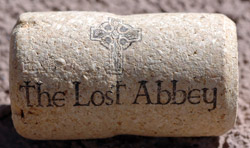 I do like the sound of bottle of beer being uncorked, the pop followed by the lively sound of carbonation, or perhaps . . .
I do like the sound of bottle of beer being uncorked, the pop followed by the lively sound of carbonation, or perhaps . . .
“Oh, bleep, we’ve got a gusher.”
Not to harp on the beer versus wine thing but that’s one thing beer has over wine (Champagne excepted). I thought about this a couple of weeks ago when I watched a waiter hand a customer in the restaurant a cork after he opened a bottle of wine. The man sniffed the cork and nodded, then the waiter poured a bit of wine. The man swirled and sniffed, then nodded again. The waiter went on to pour two full glasses.
Was there a point to this? I understand that sommeliers will sometimes smell a cork for a sign that a wine might be “corked” but it is hardly dependable. And beer is susceptible to the same problems with tainted corks.
But I don’t think you are going to catch me smelling the cork next time we have a bottle of Ommegang or Saint Somewhere or some other beer sold with a cork-and-cage top. Just doesn’t feel right.
My 18-month-old daughter demands I give her the cork to my bottles of beer. She then puts the cork to her nose and goes about her merry way. When have kids lead you astray?
For still wine, you smell the cork for signs of wine spoilage — not to determine that it’s “corked,” because the flavor profile of TCA-infected wine doesn’t translate to aromas, but to get a warning that it’s turned into vinegar, or has mighty off-putting odors, or, or, or. You also smell the cork because often it’s a wonderful aroma! It can be a good prelude to what will come.
You probably wouldn’t do this for a bottle of wine that costs as much as a bottle of Ommegang, and I’ve never heard of someone smelling a Champagne or other sparkling wine cork… but if you’re investing hundreds or thousands of dollars in a bottle, any hint helps.
I thought that the reason that the sommelier gave you the cork was to verify that it was the one that was supposed to be in the bottle (most wine have brand names or other indicators on the cork) and that it was not dried out (and therefore stored properly). As for beer I don’t see the need to sniff the cork.
Kevin is correct. There’s two reasons why a sommelier should hand you a cork and those are the two he lists: to verify the wine’s authenticity and to visually inspect the cork. I don’t really know how this whole sniffing the cork thing got started, but it cracks me up every time I see someone sniff the cork.
I’ve yet to smell a beer cork. i’d much rather wait until the beer is in a real glass before smelling anything. Sometimes the aroma will be very strong that you can smell it right away out of the bottle. But for the cork iteself? Meh. It’s a nice touch to some of the specialty beers but to me it’s just another type of cap. I do save all my corks and caps however.
Try 90% of Saisons and Biére de Gardes and you’ll get your taste of a corked beer.
Beer corks and wine corks are different. Wine corks are generally produced by punching stoppers out of slabs of cork bark (that is sheets of bark harvested from a cork tree). The corks in beer bottles are generally made from ground and re-compressed cork scrap. Since cork has evolved a naturally water and fire resistant cellular structure, very little should penetrate a cork made from a sheet of cork bark. Thus, if you’ve got a wine cork that absorbed wine or smells off or musty, you’ve probably got a bad bottle of wine. Beer corks on the other hand won’t give you that kind of indicator since they’ve be ground and re-compressed, destroying the cellular structure of the cork, and making it much more likely to absorb some of the liquid it stoppers. So smelling a beer cork doesn’t really tell you anything.
I’ve been a winemaker for many years and have a degree in Enology and Viticulture, and can tell you smelling a wine cork only makes you look like you learned about wine from watching TV sitcoms. You can’t tell anything from smelling a cork, and “corked” wine doesn’t necessarily have anything to do with the cork.
The proper thing to do with a cork a waiter hands you is to feel it, first to make sure it was stored on it’s side; is it hard, soft, wet, dry, cold, warm, spongey, flexible?
All else should be gathered from the first pour.